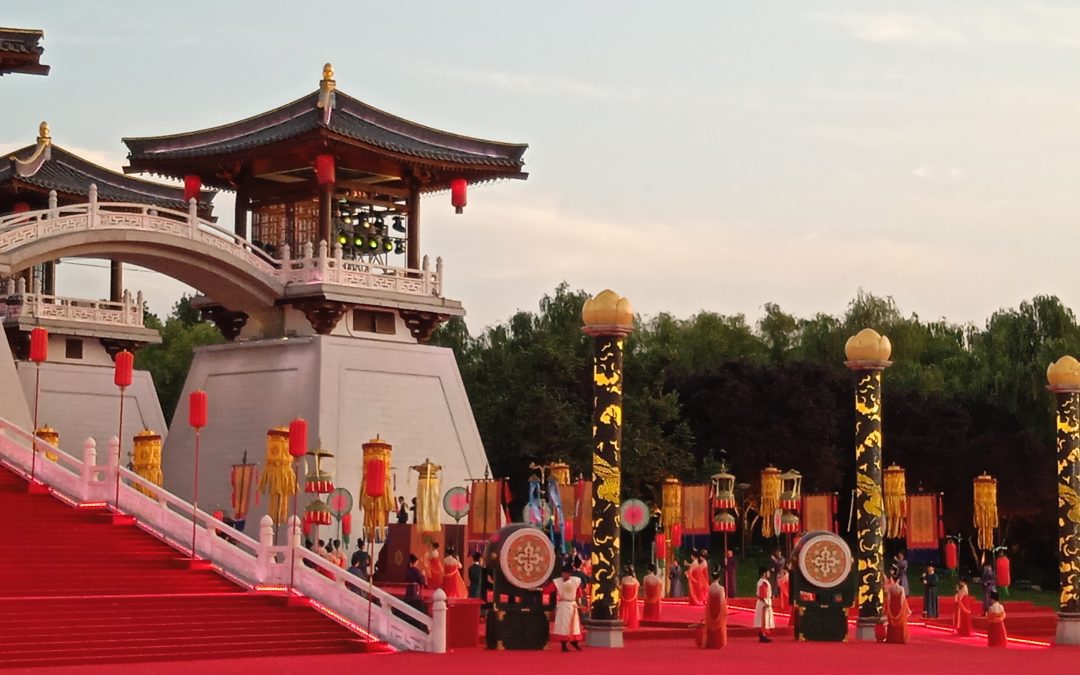We spent roughly a week in Shaanxi Province, visiting Yan’an and Xi’an cities. We were primarily there to cover the 2-day China-Central Asia Summit on 18-19 May in Xi’an, a meeting critical toward a stable, prosperous, harmonious, interconnected Central Asia through cooperation between China, Kazakhstan, Kyrgyzstan, Tajikistan, Turkmenistan and Uzbekistan.
Before the Summit, our carefully curated itineraries for Yan’an and Xi’an foreground the historic proceedings, showcasing Yan’an as sacred to the Chinese revolution, close to President Xi’s heart, and Xi’an’s history as the start of the Silk Road and host of agricultural and other innovations. We learned that over 13 years, Yan’an witnessed influences that changed China’s historical evolution and housed the CPC Central Committee, the 7th CPC National Congress and national treasure Mao Zedong, as he worked to formulate socialism with Chinese characteristics. Our itinerary took us to sites that set the tone for today’s China and its insistence on cooperation, peaceful dialogue and non-aggression.
Yan’an hosts nearly 450 old revolutionary sites. However, there was only time to tour Yan’an Qiaoergou Revolutionary Site, Yan’an Revolutionary Literature and Art Museum, Yangjialing Village, Liangjiahe Village and Zaoyuan Revolutionary Site. The revolution was not concentrated in one place; many places and people were actively involved in the struggle for independence and a better life. For me, this was enlightening to experience: the conservation of history through its artefacts—the cave houses and their furnishings, and the low-tech and hi-tech museums—and the people who proudly transmit that information to visitors, fully understanding the need for historical knowledge to ground modernisation and future progress. Within the many naturally cooled rock cave interiors, artefacts (replicas or originals were undetermined) showed the environments under which monumental thoughts, writings and decisions were produced.
I was also gratified that our tours included valuable input from 2 CPC delegates: Xue Lin, Professor of China Yan’an Cadre College, and Liu Yansheng, Professor of the Yan’an Municipal Party School of the CPC. They engaged our groups with a question-and-answer session after we visited Zaoyuan Revolutionary Site, a former Chinese date plantation, and graciously provided extra explanations at the other sites.
After a long bus ride, we arrived at Liangjiahe Village, famously known as President Xi’s second hometown, where as a youth, he and others relocated from Beijing to help the villagers shake off poverty. The village is justly proud of this connection, and the museum showcases Xi’s progress and achievements to numerous domestic and foreign visitors.
Our Xi’an itinerary included a visit to the exquisitely crafted life-size terracotta warriors, horses and other items at Emperor Qinshihuang’s Mausoleum Site Museum, and tours of the Xi’an Railway Vocational and Technical Institute, Xi’an Aiju Grain and Oil Industrial Group, Qin Chuang Yuan Innovation Promotion Centre, and LONGi Green Energy Technology. At the institute, we were impressed by the learning environment and technology used to teach future bullet train and subway drivers. The Aiju group showcased various products from its integrated industrial parks in North Kazakhstan, Alashankou and Xi’an.
I was very interested in the simultaneous translation software and dental equipment at Yuan Innovation. I was also amused by the banner, which read Yuan Innovation Power, perhaps prophetic of a new global currency. At LONGi, products on display underscored this company’s claim as the world’s most technologically advanced photovoltaic manufacturer. Both Yangling Smart Agriculture Demonstration Park and Shanghai Cooperation Organisation Modern Agricultural Exchange Centre highlighted the value of trade cooperation and agricultural technology.
The Xi’an itinerary balanced historic creative mass production technology with contemporary industrial technology, keeping the ancient capital relevant to China’s modernisation.
As it turned out, our group only covered the performance part of the Summit’s opening ceremony. The young performers were elegant, and the performance was breathtaking. For me, the down note was the abrupt departure of the dignitaries and the media, without applause for the young people’s efforts, who stood in their final poses for at least 10 minutes before they ran backstage. On Day 2, I remained at the Media Centre and covered from there. In summary, President Xi Jinping proposed that China and the Central Asian countries share mutual trust, solidarity and assistance toward cooperation in economy, trade, industrial capacity, energy and transportation, finance, agriculture, poverty reduction, green and low-carbon development, medical service, health, and digital innovation. He also proposed ensuring a united community of no conflict and enduring peace through a zero-tolerance approach to terrorism, separatism and extremism.
By jointly signing the Xi’an Declaration of the China-Central Asia Summit, President Xi and the presidents of Kazakhstan, Kyrgyzstan, Tajikistan, Turkmenistan, and Uzbekistan charted the future of a united China-Central Asia community, reinforcing the notion of good neighbours helping each other progress, solve critical issues and support innovation without interference in either country’s sovereignty.

Our group with Xue Lin, Professor of China Yan’an Cadre College, and Liu Yansheng, Professor of the Yan’an Municipal Party School of the CPC. Photo: SLCT
My takeaways from the Shaanxi Province visit are that solid planning and actioning of that planning, as evidenced by the Yan’an visits, and neighbourly consideration and cooperation obtained through the Summit, are essential keys to peaceful, sustainable modernisation, and eventual global peace. The latter is more important than ever.









